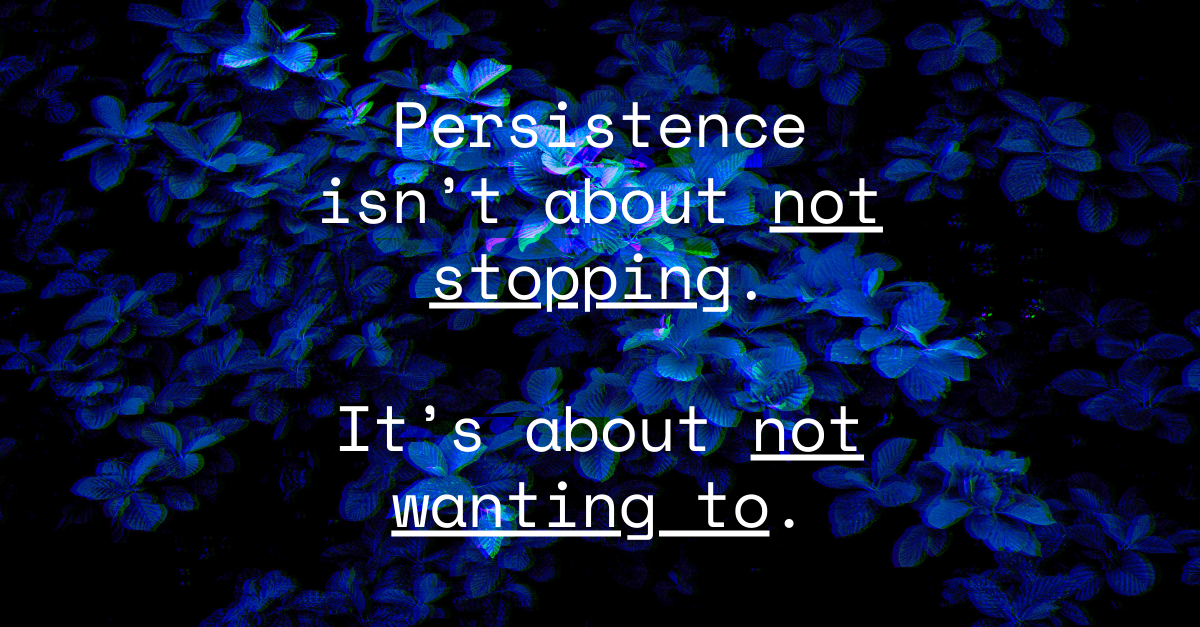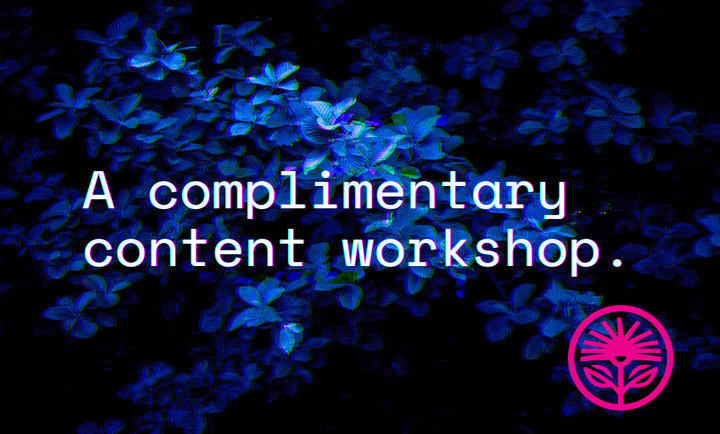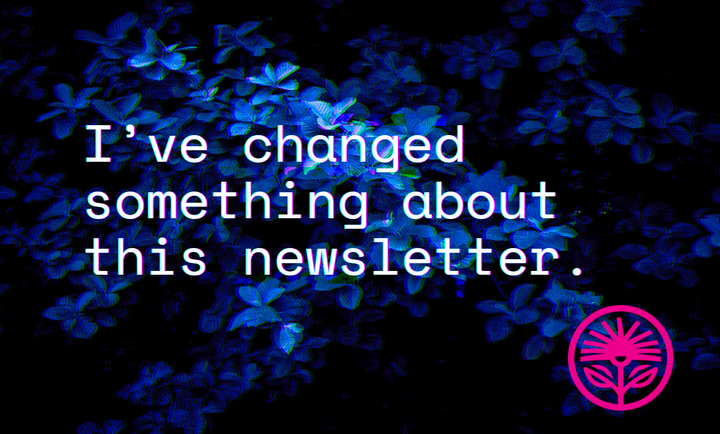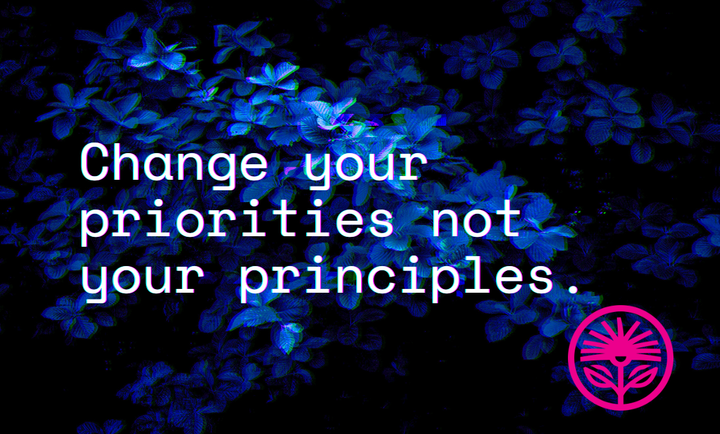Framework: Be an efficient persister
How to slow down so you can go faster.

Going slowly isn’t just slower, it’s also, often, faster.
I know that sounds like a contradiction, but you’ve probably heard the expression, “Slow is smooth, and smooth is fast.”
That’s a truism because what we usually lack is not speed, but smoothness.
We lack a sense of direction and momentum, and we confuse frantic activity for meaningful progress.
But what I’ve found is that when we slow down, focus clearly, and expend our energy carefully, we end up a lot further along than we would have if we’d chosen a “faster” path.
So here’s what we’re going to do today: We’re going to assume you want to create new marketing content for your business, to speed up sales and carve out more profit for your services.
And I’m going to show you how to use slowness to create fast, meaningful results.
Follow along as I work through the Efficient Persister framework:
Strategy
So let’s start with a strategy. I’m going to pick one largely at random, but it’s likely similar to things you’ve considered or tried in the past. And remember, a strategy is just the structure to work efficiently to get what you want, and can be expressed in three simple points:
1) Structure: Writing a blog on my website.
2) Efficiently: Focused on unique client insights, once a month.
3) Want: So that I can attract people to my business who share my perspective.
So the question now becomes, how can you make sure you can stick with that strategy for a long time—long enough for it to work—without giving up or getting impatient?
Value Delivery
First, we ask ourselves, for each part of the strategy, how does it provide value to us even if nobody sees it? And then how does it deliver value to our customers even if they don’t buy from us? Here’s an example based on the strategy we chose:
You:
1) Writing a blog on my website requires me to stay up to date with my work, the industry, and my clients which will help me serve their needs better.
2) Focusing on unique client insights once a month will keep me on the look-out for new thoughts, as I won’t want to run out, creating a virtuous cycle of insight and application.
3) Attracting clients based on shared perspectives requires me to constantly refine and focus my own perspective, making me better at articulating my value even if nobody sees my blog.
Your Customer:
1) Blog content gives them easy URLs to bookmark and link to when they need it later or want to share it.
2) Client insights provide social proof and extra credibility of your expertise, making it more comfortable to digest and integrate, and the monthly cadence is not overwhelming.
3) The focus on perspective and insight means the content will be unique and not generic “best practices”, making it more useful and valuable.
Boundaries
Now we set the boundary conditions, the constraints we’ll apply to avert Stein’s Law (“Something that cannot go on forever will stop”) and keep us working toward our goals for as long as we want to.
So how will you constrain your actions to keep them persistent? Here’s one way:
1) The blog will not branch out into a newsletter, video, or alternative content for at least 6 months.
2) The blog will not change to a more frequent cadence for at least 6 months.
3) The only metric for success for the first 6 months is: Did we publish?
Faster Alternatives
This is where we identify the obvious faster alternatives we’re not taking. These typically come in the form of industry “best practices”, or, more accurately, the “classic mistakes”:
1) A faster alternative to gaining a blog following is creating short-form video content on Instagram or TikTok.
2) A faster alternative to monthly client insights is daily “tips and tricks” content.
3) A faster alternative to focusing on perspective and qualified leads is to focus on page views or social media engagement.
Hidden Benefits
Of course, the benefit to a slower pace is that there are benefits to going slower. But they’re not always obvious, and we need to point them out to ourselves and document them so we don’t drift into the easy and dangerous work of anxious activity:
1) Writing a blog instead of creating short-form video means you have a stable of long-form content that can be indexed, tagged, repurposed, and re-edited into any number of media over time.
2) Focusing on client insights, and just once a month, instead of “tips and tricks” content forces you to focus on your work and your customers instead of what everyone else is doing and saying.
3) Focusing on perspective and qualified leads instead of simple attention requires you to know who you’re talking to, in particular, instead of shouting into the mindless void of “content”.
Increased Value
So now, at the end, we ask ourselves how we can amplify the value of our efforts—indeed, perhaps even speed them up—based on our efficient persistence:
1) We will write our blog with repurposing in mind—and think of ways to make our words more visual, more dynamic, or more active to the reader. And within 6 months we’ll have a stable of repurposeable, high-value content we can turn into anything we want to.
2) We will eschew all “best practices” and dig deep into the practices of our best customers, and find ways to amplify their value through our publishing. And within 6 months, we’ll have 6 unique insights about our clients and how they work.
3) We will take note of the feedback we get, and become intensely curious about the type of person who likes our content above all else—and find ways to establish stronger connections to them. And within 6 months, we’ll have 6 pieces of long-form content we can send to key contacts, and turn into slide decks, sales presentations, webinars, or anything else our best clients value most.
Your Turn
We started with a simple strategy for writing a blog on a website, and now look: We’ve got a structure to dig deep into customer value, derive unique insights, and establish a perspective that can owned and amplified over time.
And within 6 months, we’d have a content marketing engine up and running, focused on our areas of greatest leverage and relationships of greatest influence.
What I love most is, let’s say there are a hundred entrepreneurs reading this right now. If you all followed this framework to the letter, you’d end up running a hundred completely different businesses, focusing on completely different clients, providing completely different value.
Each of you doing what you want to do, for the people who want it most.
No “best practice” can do that.
Because the secret to efficient persistence isn’t just not stopping. It’s not wanting to.
Because you’re excited about where you’re going, and how you’ll get there.



